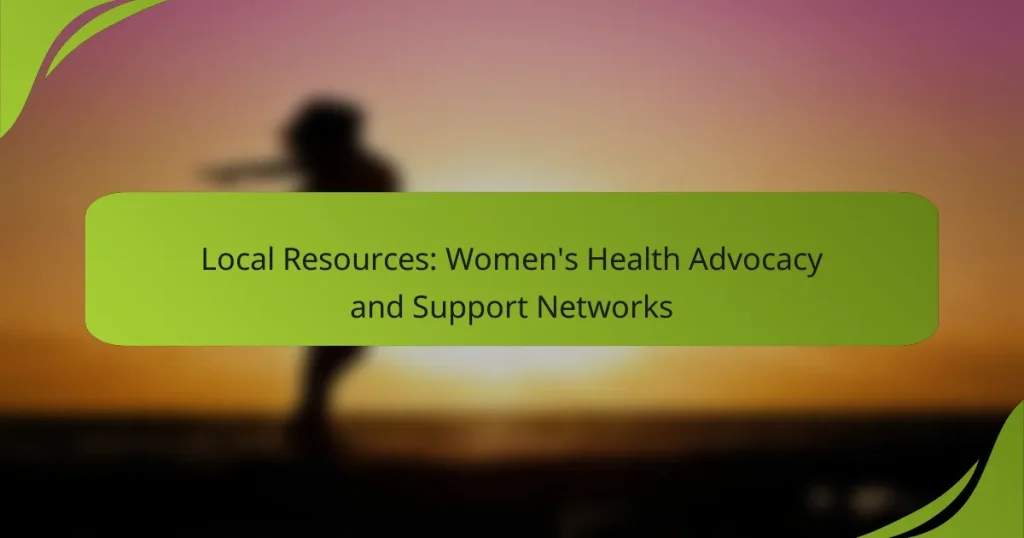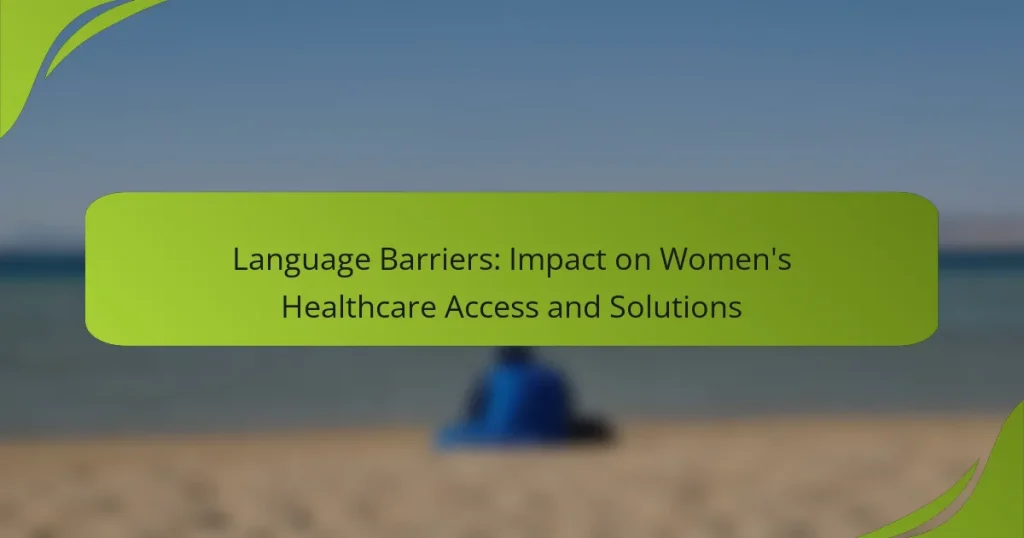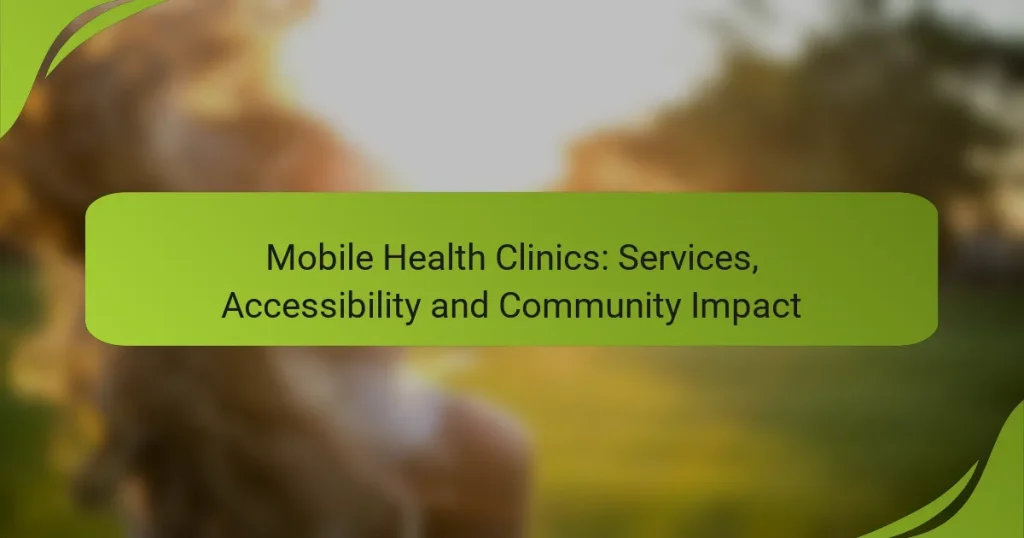Women’s health and rights initiatives are crucial in enhancing access to healthcare services, particularly in the realm of reproductive rights and addressing health disparities. By advocating for comprehensive care tailored to women’s unique health needs, these initiatives empower women to make informed decisions about their health. However, various barriers, such as socioeconomic factors and cultural stigmas, continue to challenge women’s access to essential medical care, underscoring the need for ongoing advocacy and support.
Language Barriers: Impact on Women’s Healthcare Access and Solutions
Telehealth Options: Accessibility, Benefits and Challenges
Healthcare Coverage: Women’s Rights Initiatives and Low-Income Communities
Insurance Options: Women’s Health Services and Coverage Insights
Mobile Health Clinics: Services, Accessibility and Community Impact
In-Person vs Virtual Consultations: Which Is Better and When to Use
What are the key women’s health initiatives in the United States?
Key women’s health initiatives in the United States focus on improving access to healthcare services, promoting reproductive rights, and addressing health disparities. These initiatives aim to ensure that women receive comprehensive care that meets their unique health needs.
Affordable Care Act provisions
The Affordable Care Act (ACA) includes provisions that significantly enhance women’s access to healthcare. It mandates that insurance plans cover essential health benefits, including maternity care, preventive services, and contraceptive coverage without cost-sharing.
Under the ACA, women can no longer be denied coverage due to pre-existing conditions, which often include pregnancy-related issues. This has led to millions of women gaining health insurance and accessing necessary medical services.
Planned Parenthood services
Planned Parenthood provides a wide range of health services specifically tailored to women’s needs, including cancer screenings, STD testing, and reproductive health services. These services are often offered on a sliding scale based on income, making them accessible to low-income individuals.
In addition to clinical services, Planned Parenthood also offers educational resources and advocacy for women’s health rights, helping to inform women about their healthcare options and reproductive rights.
Women’s Health Equity Act
The Women’s Health Equity Act aims to eliminate disparities in healthcare access and outcomes for women, particularly those from marginalized communities. This legislation promotes funding for research and programs that address the unique health challenges faced by women.
By focusing on health equity, the act seeks to ensure that all women, regardless of their socio-economic status or background, have access to quality healthcare services. This includes targeted initiatives for underserved populations to improve overall health outcomes.
How do women’s health rights impact access to healthcare services?
Women’s health rights significantly influence access to healthcare services by ensuring that women can obtain necessary medical care, including reproductive health services. When these rights are upheld, women experience improved health outcomes and greater autonomy over their bodies.
Legal protections for reproductive rights
Legal protections for reproductive rights establish a framework that safeguards women’s access to essential healthcare services, such as contraception and abortion. These laws vary by country and state, with some regions offering robust protections while others impose significant restrictions.
For instance, in the United States, landmark cases like Roe v. Wade historically provided women the right to choose, but recent changes have led to a patchwork of laws that can limit access. Understanding local regulations is crucial for women seeking reproductive healthcare.
Impact of Medicaid expansion
Medicaid expansion under the Affordable Care Act has significantly improved access to healthcare services for low-income women. By broadening eligibility, many women can now receive preventive care, maternal health services, and family planning resources without facing financial barriers.
States that opted for Medicaid expansion have seen higher rates of insured women, which correlates with better health outcomes. Women in these states often report increased access to necessary services, highlighting the importance of supportive healthcare policies.
What barriers do women face in accessing healthcare services?
Women encounter various barriers that hinder their access to healthcare services, including socioeconomic factors, geographic disparities, and cultural stigmas. These obstacles can significantly affect their ability to receive necessary medical care, leading to adverse health outcomes.
Socioeconomic factors
Socioeconomic status plays a crucial role in women’s access to healthcare. Women from low-income backgrounds may struggle to afford medical expenses, including insurance premiums, co-pays, and out-of-pocket costs. This financial strain can lead to delayed or foregone care, exacerbating health issues.
Additionally, education level influences health literacy, impacting women’s understanding of available services and their rights. Women with limited education may not be aware of preventive care options or how to navigate healthcare systems effectively.
Geographic disparities
Geographic location significantly affects women’s access to healthcare services. Rural areas often lack adequate healthcare facilities, leading to longer travel times and increased costs for women seeking care. This can result in fewer routine check-ups and delayed treatment for health conditions.
Urban settings may offer more healthcare options, but disparities still exist based on neighborhood socioeconomic status. Women living in underserved urban areas may face similar challenges as those in rural regions, including limited access to specialized services and higher rates of uninsured individuals.
What role do community health organizations play?
Community health organizations are vital in enhancing access to healthcare services for women. They provide essential resources, education, and support tailored to meet the unique needs of women in various communities.
Local outreach programs
Local outreach programs focus on connecting women with necessary healthcare services in their communities. These initiatives often include mobile clinics, health fairs, and educational workshops that address specific health issues such as reproductive health, maternal care, and chronic disease management.
For example, a mobile clinic may visit underserved neighborhoods monthly, offering free screenings and consultations. This direct approach helps to reduce barriers such as transportation and cost, making healthcare more accessible.
Support for marginalized groups
Community health organizations often prioritize support for marginalized groups, including low-income women, immigrants, and those with disabilities. They provide tailored services that consider cultural sensitivities and specific health challenges faced by these populations.
Programs might include language assistance, culturally competent care, and financial aid for medical expenses. By addressing these unique needs, organizations can significantly improve health outcomes and empower women to seek the care they require.
How can technology improve women’s health access?
Technology can significantly enhance women’s access to healthcare services by providing remote consultations, personalized health tracking, and timely information. These innovations help overcome barriers such as geographical distance, scheduling conflicts, and limited availability of specialized care.
Telehealth services
Telehealth services allow women to consult healthcare providers via video calls or phone conversations, making it easier to access medical advice without traveling. This is particularly beneficial for those living in rural areas or with mobility issues, as it saves time and reduces costs associated with in-person visits.
When using telehealth, ensure that the platform is secure and compliant with local regulations, such as HIPAA in the United States. Many providers offer services for various health concerns, including mental health, reproductive health, and chronic conditions, often with flexible scheduling options.
Health apps for tracking wellness
Health apps can help women monitor various aspects of their wellness, including menstrual cycles, pregnancy, nutrition, and exercise. These applications often provide personalized insights and reminders, empowering users to take charge of their health and make informed decisions.
When selecting a health app, consider features such as data privacy, user reviews, and compatibility with wearable devices. Popular options include period trackers, fitness apps, and mental health resources, which can be tailored to individual needs and preferences.
What are the emerging trends in women’s health rights?
Emerging trends in women’s health rights focus on increasing awareness and access to healthcare services that address specific needs, particularly in mental health and intersectionality. These trends are reshaping how healthcare systems respond to women’s unique health challenges and rights.
Increased advocacy for mental health
There is a growing emphasis on mental health as a critical component of women’s overall health rights. Advocacy groups are pushing for policies that ensure women have access to mental health services, recognizing the impact of societal pressures and gender-based violence on mental well-being.
Practical steps include integrating mental health screenings into routine healthcare visits and promoting awareness campaigns that destigmatize mental health issues. Women should seek providers who specialize in mental health and understand the unique challenges they face.
Focus on intersectionality in healthcare
Intersectionality in healthcare acknowledges that women experience health issues differently based on various factors such as race, socioeconomic status, and sexual orientation. This approach aims to create more inclusive healthcare policies that address the diverse needs of all women.
Healthcare providers are encouraged to adopt culturally competent practices and consider the multiple identities of their patients. For example, programs that specifically target low-income women or women of color can help bridge gaps in access and treatment.
What future initiatives are being proposed for women’s health?
Future initiatives for women’s health focus on enhancing access to comprehensive healthcare services, particularly in reproductive and maternal health. These initiatives aim to address existing gaps and promote equitable healthcare for women globally.
Expansion of reproductive health services
Expanding reproductive health services involves increasing access to contraception, family planning, and safe abortion services. This can be achieved through community health programs and partnerships with local organizations to ensure that women receive the necessary information and resources.
Countries may consider integrating reproductive health services into primary healthcare systems, making them more accessible. For instance, providing training for healthcare providers can improve service delivery and ensure that women feel comfortable seeking help.
Legislation for maternal health improvements
Legislation aimed at improving maternal health focuses on establishing standards for prenatal and postnatal care. Governments can implement policies that require healthcare facilities to meet specific quality benchmarks, ensuring safe childbirth practices.
Additionally, financial support for low-income families can help reduce barriers to accessing maternal healthcare. Programs that cover costs related to pregnancy and childbirth can significantly improve outcomes for mothers and their infants.
Global health partnerships for women’s rights
Global health partnerships are essential for advancing women’s rights and health initiatives. Collaborations between governments, NGOs, and international organizations can lead to the sharing of best practices and resources, enhancing the effectiveness of health programs.
These partnerships can also focus on advocacy efforts to raise awareness about women’s health issues, influencing policy changes at both local and global levels. By working together, stakeholders can create a more supportive environment for women’s health initiatives worldwide.






